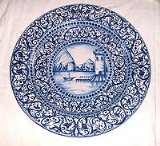
Majolica
Encyclopedia

Tin-glazed pottery
Tin-glazed pottery is a majolica pottery covered in glaze containing tin oxide which is white, shiny and opaque. The pottery body is usually made of red or buff colored earthenware and the white glaze was often used to imitate Chinese porcelain...
, typically brightly painted over an opaque white background glaze, with an earthenware
Earthenware
Earthenware is a common ceramic material, which is used extensively for pottery tableware and decorative objects.-Types of earthenware:Although body formulations vary between countries and even between individual makers, a generic composition is 25% ball clay, 28% kaolin, 32% quartz, and 15%...
body.
The term was first used of Maiolica
Maiolica
Maiolica is Italian tin-glazed pottery dating from the Renaissance. It is decorated in bright colours on a white background, frequently depicting historical and legendary scenes.-Name:...
, luxury ceramics from Renaissance Italy, which continued to be made there in increasingly cheap and popular forms, and spread to several other European countries, some of which are known as faience
Faience
Faience or faïence is the conventional name in English for fine tin-glazed pottery on a delicate pale buff earthenware body, originally associated with Faenza in northern Italy. The invention of a white pottery glaze suitable for painted decoration, by the addition of an oxide of tin to the slip...
. Delftware
Delftware
Delftware, or Delft pottery, denotes blue and white pottery made in and around Delft in the Netherlands and the tin-glazed pottery made in the Netherlands from the 16th century....
from the Netherlands
Netherlands
The Netherlands is a constituent country of the Kingdom of the Netherlands, located mainly in North-West Europe and with several islands in the Caribbean. Mainland Netherlands borders the North Sea to the north and west, Belgium to the south, and Germany to the east, and shares maritime borders...
and English Staffordshire ware are other local descendents, not usually known as majolica. In the 19th century there was a revival of luxury forms, known in English-speaking countries as Victorian majolica
Victorian majolica
Victorian Majolica is earthenware pottery made in 19th century Britain, Europe and the USA with molded surfaces and colorful clear lead glazes.-History:...
, with much use of moulded surfaces as well as colourful glazes. Popular and folk forms have continued in many countries, including the Mexican Talavera majolica
Talavera (pottery)
Talavera pottery of Puebla, Mexico is a type of majolica pottery, which is distinguished by a milky-white glaze. Authentic Talavera pottery only comes from the city of Puebla and the nearby communities of Atlixco, Cholula, and Tecali, because of the quality of the natural clay found there and the...
.
Name
The name is thought to come from the medieval Italian word for Majorca, an island on the route for ships bringing Hispano-Moresque wares from Valencia to Italy. An alternative explanation of the name is that it comes from the Spanish term obra de MalagaMálaga
Málaga is a city and a municipality in the Autonomous Community of Andalusia, Spain. With a population of 568,507 in 2010, it is the second most populous city of Andalusia and the sixth largest in Spain. This is the southernmost large city in Europe...
, denoting “wares from/in the style of Malaga”, which continued to be used for Hispano-Moresque ware long after the industry had transferred to the area round Valencia, or obra de mélequa, the Spanish name for luster.
In the 15th century, the term maiolica referred solely to lusterware
Lusterware
Lusterware or Lustreware is a type of pottery or porcelain with a metallic glaze that gives the effect of iridescence, produced by metallic oxides in an overglaze finish, which is given a second firing at a lower temperature in a "muffle kiln", reduction kiln, which excludes oxygen.The first use...
, including both Italian-made and Spanish imports, and tin-glaze wares were known as bianchi (white ware). Eventually the term came to be used when describing ceramics made in Italy, lustered or not, of tin-glazed earthenware, and then those from other countries. With the Spanish conquest of Mexico
Mexico
The United Mexican States , commonly known as Mexico , is a federal constitutional republic in North America. It is bordered on the north by the United States; on the south and west by the Pacific Ocean; on the southeast by Guatemala, Belize, and the Caribbean Sea; and on the east by the Gulf of...
, tin-glazed maiolica wares came to be produced in the Valley of Mexico as early as 1540, at first in imitation of tin-glazed pottery imported from Seville
Seville
Seville is the artistic, historic, cultural, and financial capital of southern Spain. It is the capital of the autonomous community of Andalusia and of the province of Seville. It is situated on the plain of the River Guadalquivir, with an average elevation of above sea level...
.
Today in English "maiolica" is generally used to describe the finer and earlier wares, and "majolica" for those from the 19th century onwards, though usage varies.

